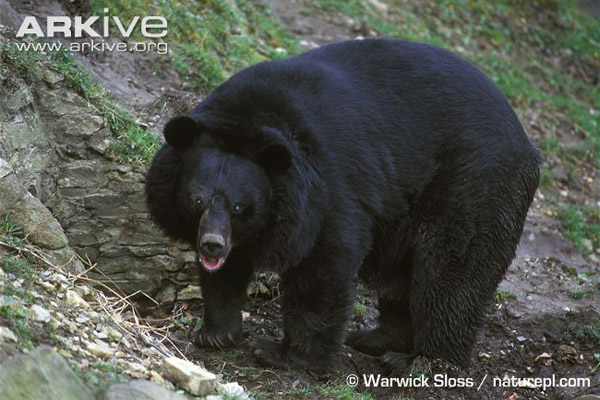Bears
ASIATIC BLACK BEAR
Ursus (or Selenarctos) thibetanus
Physical Description
The Asiatic Black Bear’s scientific name, Ursus thibetanus, translates into “Moon Bear of Tibet”. The Bear is also known as the Tibetan, Himalayan, or Formosan Black Bear, the Collared Bear, the Moon Bear, and the White-breasted Bear.
The Asiatic Black Bear is dark brown and black, with a distinct crescent moon-shaped patch of cream-coloured fur on its chest. The ears of the Asiatic Black Bear appear much larger than those of other bear species. The Asiatic Black Bear is a medium-sized bear, with a body length of 127 to 188 centimetres (50 to 74 inches).
Adult male bears weigh between 100 and 200 kilograms (220 and 440 pounds), while adult females weigh between 50 and 125 kilograms (110 to 275 pounds), and have lighter muzzles than the males.
Habitat
The Asiatic Black Bear inhabits thickly forested areas in the hills and mountains and moist tropical forests below alpine levels. The Bear occurs at altitudes as high as 3,000 metres (9,800 feet) in the summer. In the winter, however, the Asiatic Black Bear descends to lower altitudes. The Asiatic Black Bear is found in far eastern Russia, southern Asia, Tibet, China, and Japan.
The Bear’s habitat range in Tibet includes the Himalayan Mountains in the South, the hilly and mountainous regions, including the Hengduan Mountains, in the East and Southeast, and the area from Yushu Prefecture east towards the Gyalmo Tsawa Rong region in the Northeast.
Eating Habits
The Asiatic Black Bear is omnivorous. Like most other wild animals, the Bear favors foods that yield the greatest dietary value compared to the amount of energy needed to acquire the foods. Seasonal climate and geographical location also affect the Asiatic Black Bear’s choice of diet. The Asiatic Black Bear is mainly a carnivore, but it also eats termites, beetles, larvae, honey, fruits, nuts, berries, grasses, and herbs.
Behaviour and Reproduction
The Asiatic Black Bear generally sleeps through most of the day and hunts and eats at night. In the colder areas of the Bear’s habitat range, the bears retreat to dens to hibernate in the winter. The bears most often make their dens in rock cavities or hollow trees. It is not known whether hibernation occurs in the consistently warm areas of the Asiatic Black Bear’s habitat range. The size of a single bear’s territory typically ranges from seven to 13 square kilometres (three to five square miles), but may vary significantly depending on the availability of food sources.
The Asiatic Black Bear usually does not reach sexual maturity until it is between three to four years of age. When exactly the Bear’s breeding season begins depends upon climatic conditions. The timing of the breeding season thus varies from year to year, as well as across Bear’s habitat range. The Asiatic Black Bear typically mates between June and July, though, and female bears generally give birth in January or February.
Asiatic Black Bear mothers give birth in dens they have sought out during the winter or early spring. Most mothers give birth to one to four cubs per breeding season. Each cub weighs about 227 to 298 grams (eight to 10.5 ounces) at birth. Cubs are born blind and helpless, but develop quickly in the few weeks after their birth, nourished by the rich milk of their mothers. Though cubs are usually weaned by the time they are six months old, they stay with their mothers for two to three years. Females typically do not breed again in the year after having given birth, because they are still caring for yearlings.
Asiatic Black bears in captivity have lived beyond 30 years, but the average life span of bears in the wild is unknown. The Bear’s predators include wolves, tigers, and Brown bears.
Present Status
The Asiatic Black Bear has been categorized as Vulnerable by the IUCN, The World Conservation Union, as documented in their 2003 IUCN Red List of Threatened Species. The Asiatic Black Bear has also been included in Appendix I of the UN Convention on International Trade in Endangered Species, or CITES, since 1979. The Asiatic Black Bear is under second class protection in China and is included in Schedule III of the Indian Wild Life (Protection) Act of 1972. Unfortunately, legal protection for the Asiatic Black Bear is rarely enforced. The Asiatic Black Bear population in China was recently estimated to be approximately 7,000.
Threats to Survival
Habitat destruction and poaching are the major threats to the Asiatic Black Bear’s survival. The Bear’s habitat has been lost and degraded as a result of logging and infrastructure development, including the expansion of human settlements and road networks. Most of the Asiatic Black Bear’s habitat range is now composed of highly isolated and non-contiguous areas of land, all of which are subject to human encroachment. As the bear species most favored by the Asian medicinal market for the presumed potency of its organs, the Asiatic Black Bear population is also suffering from the effects of poaching. The bile and gall bladders of the Bear are highly sought after for their medical use in reducing inflammation and fighting fevers. Poachers also sell the Asiatic Black Bear’s pelt and paws.
References
Asiatic Black Bears, Asiatic Black Bears, http://www.asiatic-black-bears.com, Aug 2004.
BBC, Science and Nature – Wildfacts – Asiatic Black Bear, http://www.bbc.co.uk/nature/wildfacts/factfiles/10.shtml, Aug 2004.
Bear Taxon Advisory Group, Asiatic Black Bear, http://www.bearden.org/asibear.html, Aug 2004.
Bear Specialist Group, 1996: Ursus thibetanus. In: IUCN, 2003: 2003 IUCN Red List of Threatened Species, http://www.redlist.org, Aug
2004.
PBS, The Living Edens: Bhutan Animal Archive – Black Bear, http://www.pbs.org/edens/bhutan/a_bb.htm, Aug 2004.
Servheen, C., Hereto, S., and Peyote, B., 1999: Bears: Status Survey and Conservation Action Plan, IUCN Bear and Polar Bear Specialist
Groups, IUCN, Gland, Switzerland and Cambridge, UK.
Stirling, Ian, 1993: Bears, Majestic Creatures of the Wild, Rodale Press, Emmaus, Pennsylvania.
By: Environment and Development Desk, DIIR, CTA.



comment 0